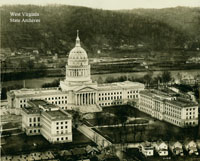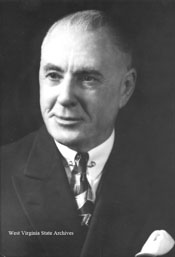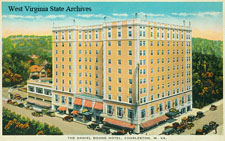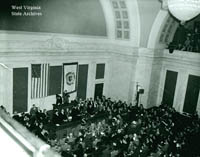

Chapter Five |
 Governor Herman Guy Kump
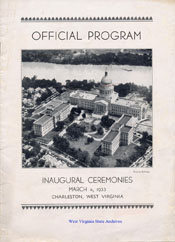 Excerpts from Kump's Inaugural Program |
When he became governor on March 4, 1933, Herman Guy Kump was the last West Virginia governor to be inaugurated in March. He also was the first governor to be inaugurated at the present state capitol building. Activities for the "bread and water" inaugural, as Kump's less grand inauguration at the height of the Great Depression was termed, began with the largest inaugural parade as of that date. The parade had somewhere between 2,000 and 3,000 participants, consisting of motorcycle police; U.S. marines; Grand Marshal C. C. Pierce; the 150th Infantry; the governor; elective officers; 39 automobiles with members of the House and Senate; drum and bugle corps from Fairmont, Moundsville, Logan, Huntington, and Charleston; bands from West Virginia University, Parkersburg High, Huntington High, Charleston High, Cabin Creek High, East Bank, and Clendenin High; American Legionnaires and other veterans; Boy Scouts; a "novelty" car, a replica of a French wartime railroad car, carrying Legionnaires from Huntington; and, near the governor's automobile in the order of procession, groups from Kump's home town of Elkins:the H. W. Daniels Post 29 of the American Legion, a U.S. Naval Reserve Unit, the Queen Sylvia Band, and the Elkins High School band. The parade route went from Kanawha and Broad streets westward to Capitol Street and north to Lee (where the old capitol had been located), then east to Brooks, south to Quarrier, east to Duffy (where the new capitol was under construction), north to Washington, east to Oney and to the capitol.
At the capitol, the Queen Sylvia Band played "Our Governor," a new march written by Edwin Peters for Kump's inauguration. Before giving his inaugural address, Kump took the oath of office with his hand on the Bible first used for Henry Mason Mathews's inauguration in 1877 and subsequently used for those of Jacob B. Jackson, E. Willis Wilson, A. B. Fleming, and William A. MacCorkle. |
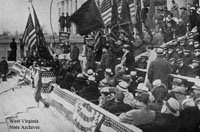 Inauguration of Governor Herman Guy Kump
|
After the ceremonies concluded, Governor and Mrs. Kump hosted an informal luncheon at the Governor's Mansion. Afterwards, the Women's Democratic Club of Charleston held a tea at the Woman's Club for the governor's wife and wives of the members of the Board of Public Works. In what the Charleston Daily Mail described as "the largest inaugural reception" in the state's history, for three hours the Kumps received thousands of people in the governor's reception room at the capitol. Although there was no official inaugural ball, the Pioneer Club sponsored a formal dance at the Kanawha Country Club in connection with the inauguration, and Governor and Mrs. Kump as well as other officials were guests of honor.
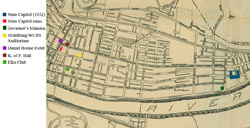
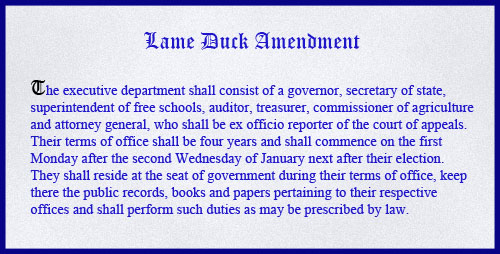
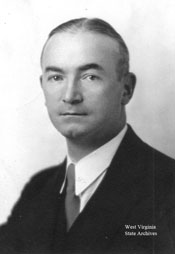 Governor Homer A. Holt |
Homer Adams Holt was the first governor to be inaugurated under the "Lame Duck Amendment," the constitutional amendment ratified in 1934 that moved the start of the governor's term from March to January. In 1937, the inauguration took place on January 18, which began with a steady rain that stopped shortly before the parade was scheduled to begin. An estimated 40,000 people saw the parade, which began at Broad and Kanawha streets, moved down Kanawha to Capitol, north to Washington, and east to the capitol along a route decorated for the occasion. Police, national guardsmen, marines from the South Charleston naval ordnance plant, political figures, Red Cross representatives, Boy Scouts, veterans organizations, and bands from Charleston, South Charleston, Beckley, Logan, Wyoming County, Cabin Creek, and Bluefield participated. Holt and Governor Kump rode in a car behind the band and color bearers from Greenbrier Military School, Holt's alma mater. |
 Homer Holt riding in an automobile in the inaugural parade. Holt Collection
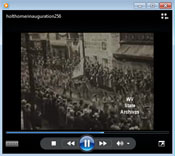 Parade footage (no audio) |
|
A platform had been erected on the north portico, but, because of the rain, the inaugural ceremony was moved to the House of Delegates. The House gallery was packed, and many crowded the corridors. The Greenbrier Military School band could not fit in the House, and that portion of the program had to be cancelled. The West Virginia Legionettes, from Keyser, were unable to perform due to illness, which also kept former Governor John Cornwell, master of ceremonies, from coming.
After outgoing Governor Kump introduced the "courageous and patriotic servant, who now succeeds me," he was presented with a gold watch. Homer Holt then took the oath on a Bible given to him by his mother and gave his inaugural address. At the end of the ceremonies, Mesdames Edna Kump and Isabel Holt and the two Holt daughters, Julia and Isabel, were introduced to the crowd. That evening, a public reception was held at the governor's reception room. Throughout the evening, music was played in the rotunda of the capitol and the dome and all offices were lighted. Beginning at 9:30 p.m., an inaugural ball was held at the Midelburg Auditorium with music provided by the Colonels Orchestra. |
 Excerpts from Holt's Inaugural Program
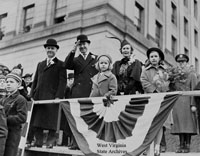 L-R: Governor Kump, Governor Holt, Isabel Holt, Mrs. Holt, and Julia Holt at inauguration. Holt Collection |
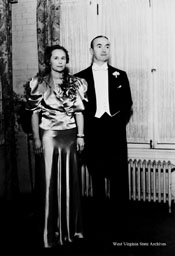 Governor and Mrs. Holt. |
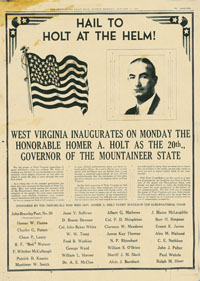 Full-page Ad. |
| On January 13, 1941, "instantly after midnight," Matthew Mansfield Neely took the oath of office as West Virginia governor before a small group of friends and associates in order to name his successor in the United States Senate. Judge Jo Kenna of the Supreme Court administered the oath in the governor's mansion. Less than an hour later the oath was filed with the secretary of state, and Neely announced his appointment of Joseph Rosier to the Senate, a move that would lead to conflict over whether Neely's appointee or Governor Holt's last-minute appointee would be allowed to take the Senate seat. |
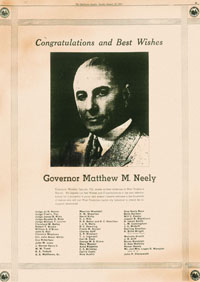 Full-page Ad. |
With completion of the widening of Kanawha Street, the new boulevard along the river was the designated route for the entire inaugural parade. Starting near the Kanawha County courthouse, the parade moved up the boulevard to the capitol. Participants included Holt and Neely in the official car, members of the Board of Public Works, and other distinguished guests; bands from West Virginia University, Marshall College, Charleston/Stonewall Jackson combined, DuPont High from Belle, and a professional group from Charleston; the 150th Infantry National Guard, Montgomery's American Legion post drum and bugle corps, sailors from the naval reserves, and members of various branches of the military; the Loyal Order of Moose and former serviceman Edward Sampson painted in gilt to represent a World War I doughboy statue. Neely's inaugural parade contained what are believed to be two firsts: (1) African American bands from Douglas High of Huntington and Garnet High of Charleston; and, (2) labor representation in the form of members of the United Mine Workers of America and West Virginia State Federation of Labor, and a float provided by the state Federation of Labor.
 South facade of the State Capitol. | At the capitol, the boulevard between the south side of building and the river had been roped off for the public to view the ceremonies, and an estimated 15,000 witnessed the event. The capitol columns were draped with large U.S. flags, and the national and state colors decorated the sides of a speakers' platform. Among those seated on the platform who had come from Washington DC to see their former Senate colleague inaugurated were Sherman Minton of Indiana, Claude Pepper of Florida, Joseph Guffey of Pennsylvania, and Harry S. Truman of Missouri. Judge Jo Kenna administered the oath to Neely a second time before Neely gave his inaugural address. Between the two formalities, the bands played "Hail to the Chief" for the first time at a West Virginia governor's inauguration. | 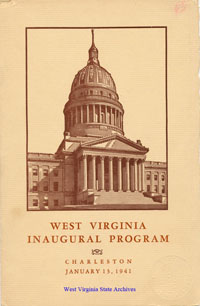 Cover of inaugural program |
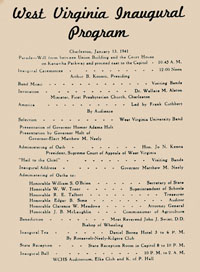 Inaugural program. |
After the inauguration, a private luncheon was held for the Neelys at the governor's mansion. From 3:00 to 6:00, Mrs. Neely and daughter Corinne were guests at a tea at the Daniel Boone Hotel given by the women's division of the Neely-Kilgore campaign. (Bess Harrison, who soon would be appointed state historian and archivist by Governor Neely, was general chairman of the tea.)
|  Knights of Pythias Hall. |
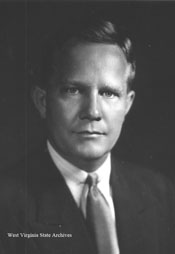 Governor Clarence W. Meadows |
The inauguration held four years later on January 15, 1945, for Clarence Watson Meadows was a simple affair appropriate to the wartime circumstances in which the country found itself. With no parade, parties, or balls, the inaugural consisted of the ceremony and an evening reception. Bad weather forced the formal ceremonies inside to the Senate chamber, where Meadows took the oath and gave his inaugural address. | 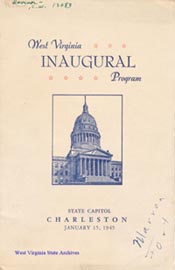 Cover of inaugural program |
 Meadows giving his inaugural address. |
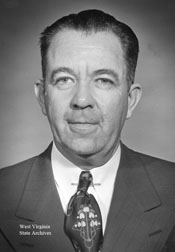 Governor Okey L. Patteson |
Inaugural ceremonies again were held in the Senate chamber on January 17, 1949, when Okey Leonidas Patteson became the state's twenty-third governor. The high school band from Patteson's hometown of Mount Hope, along with Charleston High, Stonewall Jackson High, and Elkins Highlanders Bag-Pipe bands, played in the capitol corridors. The Mount Hope band had the honor of playing "Hail to the Chief" between Patteson's taking of the oath of office and his inaugural speech. Before Governor Meadows introduced Patteson, Frank Kincheloe, who had led the singing of "America" at many of the inaugurations dating back to Ephraim Morgan's in 1921, led the singing for what would be the last time. Leaving the Senate Chamber at the end of the ceremony, Patteson and his family passed between two rows of regimental and company commanders of the National Guard.
Governor and Mrs. Meadows hosted a luncheon at the governor's mansion following the ceremony. Between 8:00 and 10:00 that evening, Governor and Mrs. Patteson were part of the receiving line at a reception in the governor's reception room. |
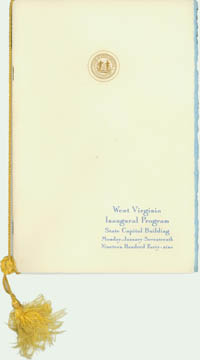 Excerpts from Patteson's inaugural Program |
The Senate chamber during Patteson's inauguration. In the view at right, Patteson can be seen sitting on a stool. He lost both legs below the knee in a 1932 hunting accident and wore prostheses. From Governors Negs. |
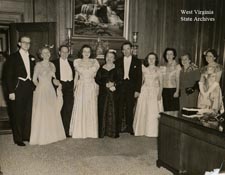 Governor Patteson and Mrs. Patteson, flanked by their daughters Fannie and Anna, former Governor Meadows, and others. |

